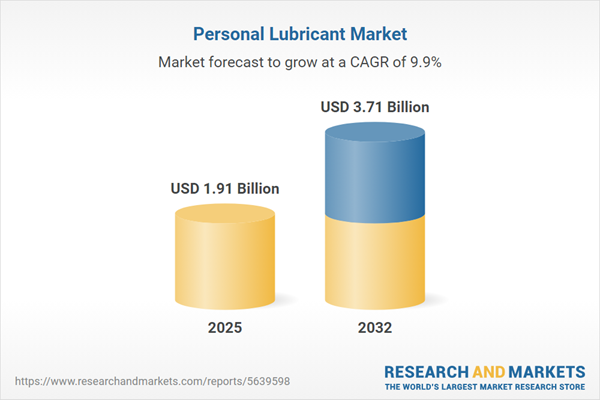Speak directly to the analyst to clarify any post sales queries you may have.
The personal lubricant market is experiencing dynamic change as new technologies emerge, regulatory requirements increase, and consumer expectations evolve. Senior decision-makers must leverage strategic intelligence to navigate this complexity, seize emerging growth opportunities, and maintain agility and compliance at all times.
Personal Lubricant Market Snapshot
Maintaining consistent growth, the global personal lubricant market benefits from continuous product development and expanding user adoption. Innovative formulation approaches enable businesses to address a broad mix of consumer preferences and requirements, strengthening their position across varied demographics. Investors prioritizing agile operations and the optimization of supply chains are seeing improved competitiveness in established markets and new geographies. Achieving lasting success in this evolving landscape demands close attention to compliance and proactive risk management, ensuring readiness for fluctuating consumer and regulatory trends.
Scope & Segmentation: Strategic Opportunities in the Personal Lubricant Market
- Product Types: Hybrid, oil-based, silicone-based, and water-based lubricants all offer brands methods to satisfy differing user needs. A proliferation of both flavored and unflavored variants gives companies the potential to personalize offerings and stand out in targeted niches.
- Forms: Creams, gels, liquids, and sprays are deployed to serve a range of preferences, delivering diverse texture and application options that widen market accessibility across user segments.
- Distribution Channels: A variety of retail venues—including convenience stores, pharmacies, supermarkets, specialty shops, hypermarkets, branded web platforms, major online marketplaces, and digital pharmacies—broaden access while supporting customer choice throughout the buying cycle.
- End Users: Companies maintain portfolios for both male and female consumers, spanning varied age ranges, and adapt their engagement methods to different demographic cohorts to ensure relevance and sustainable brand reach.
- Price Ranges: Economy, premium, organic, and natural classifications meet the needs of price-conscious buyers as well as those seeking quality or environmentally responsible options, setting the stage for versatile responses to market trends.
- Regional Coverage: Operations extend across the Americas, Europe, Middle East and Africa, and Asia-Pacific, adjusting to regional regulations and consumer cultural preferences in markets such as the United States, Canada, Brazil, Germany, UAE, South Africa, China, and India.
- Leading Companies: Key participants—Reckitt Benckiser Group plc, Church & Dwight Co., Inc., Kenvue Inc., Edgewell Personal Care Company, Pjur Group AG, Trigg Laboratories, Sliquid LLC, Wicked Sensual Care LLC, Doc Johnson Enterprises, and BioFilm Inc.—advance innovation and are increasing their reach regionally to navigate the evolving landscape.
Key Takeaways for Senior Decision-Makers
- Enhancing transparency in ingredient disclosure and health-focused communication supports compliance and builds trust as the industry adapts to stricter regulations and growing consumer awareness.
- Investing in next-generation formulations, including advanced hybrid products, positions brands at the forefront of evolving market demand, enhancing resilience and loyalty in volatile conditions.
- Integrating a robust omnichannel approach, spanning both physical and digital platforms, strengthens customer accessibility and maximizes interaction across the purchasing journey.
- Prioritizing environmentally conscious packaging solutions, such as sustainable or biobased materials, signals commitment to regulatory compliance and global sustainability trends.
- Customizing regional strategies in response to shifting local legislation and cultural norms enhances brand relevance and sustains momentum in developing and high-growth markets.
- Pursuing mergers or forming strategic alliances can accelerate entry into new territories and improve adaptability to legislative and consumer-driven changes.
Tariff Impact: Navigating Cost Pressures and Supply Chain Resilience
New United States tariffs targeting essential raw materials within the personal care industry are influencing how manufacturers approach sourcing and logistics. Companies are increasingly targeting nearshoring and deeper collaboration with local suppliers, aiming to counteract rising costs and maintain uninterrupted supply. These tactics bolster the ability to respond to operational disruptions as global trade and policy environments develop.
Methodology & Data Sources
This research incorporates executive-level interviews, expert consultations, regulatory examination, and supporting secondary data. Synthesizing these inputs, the report delivers actionable insights specifically for senior leaders emphasizing strategic planning and rigorous compliance.
Why This Report Matters
- Detailed segmentation clarifies pathways for strategic market entry, risk mitigation, and informed planning as the sector adjusts to new challenges.
- Frequent monitoring of market sentiment and regulatory shifts equips organizations with tools for agile response and optimized compliance strategies.
- Guidance on operational excellence and innovation supports business leaders striving for sustained advantage within a highly contested environment.
Conclusion
This analysis equips senior executives with the guidance needed for informed decision-making, ensuring ongoing relevance and resilience as the personal lubricant market continues to evolve and diversify.
Additional Product Information:
- Purchase of this report includes 1 year online access with quarterly updates.
- This report can be updated on request. Please contact our Customer Experience team using the Ask a Question widget on our website.
Table of Contents
3. Executive Summary
4. Market Overview
7. Cumulative Impact of Artificial Intelligence 2025
Companies Mentioned
The companies profiled in this Personal Lubricant market report include:- Reckitt Benckiser Group plc
- Church & Dwight Co., Inc.
- Kenvue Inc.
- Edgewell Personal Care Company
- Pjur Group AG
- Trigg Laboratories, Inc.
- Sliquid LLC
- Wicked Sensual Care LLC
- Doc Johnson Enterprises, Inc.
- BioFilm Inc.
Table Information
| Report Attribute | Details |
|---|---|
| No. of Pages | 194 |
| Published | October 2025 |
| Forecast Period | 2025 - 2032 |
| Estimated Market Value ( USD | $ 1.91 Billion |
| Forecasted Market Value ( USD | $ 3.71 Billion |
| Compound Annual Growth Rate | 9.9% |
| Regions Covered | Global |
| No. of Companies Mentioned | 11 |









